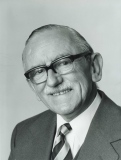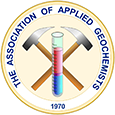JOHN STUART WEBB (1920-2007)
JOHN STUART WEBB (1920-2007)

John Stuart Webb, the British "father of applied geochemistry", died at Redhill, England, on 2 April 2007. He was born at Balham, London on 28 August 1920, eldest child of George Stewart Webb and his wife Caroline Rabjohns, née Pengelly. His sister, Mona Audrey, was born in 1924.
He attended St. Mary's school, Balham (1925-30) and Westminster City School, London (1930-38). Despite having given a paper “On Earthquakes” to the school Science Society in 1938, he tossed a coin in his father’s garage (where he had a chemical laboratory) to decide whether he should read medicine or geology. He subsequently enrolled at the Royal School of Mines, Imperial College of Science and Technology, London. He graduated BSc (First Class Honours) in Mining Geology in 1941, having received the Murchison medal and prize (1939), the Brough medal and prize (1940), the Clement le Neve Foster prize (1941) and Cullis Testimonial Fund (1941).
Following a short period as assistant mining geologist to the Government's Non-Ferrous Metallic Ores Committee, he joined the Royal Engineers in 1941, but was transferred in 1943 to the Geological Survey of Nigeria, as an economic mineralogist, to look for tantalum. He was invalided back to England in 1944, having caught both tick-typhus and malaria. On recovery, he was awarded a Beit Scientific Research Fellowship at IC and began his thesis on ‘The origin and mineral paragenesis of the tin lodes of Cornwall’, for which he was awarded the Judd Prize in 1946 and his PhD (Mining Geology) and Diploma of Imperial College in 1947. Appointed, by London University, Lecturer in Mining Geology, he remained at Imperial College, becoming Reader in Applied Geochemistry (1955), Professor of Applied Geochemistry (1961), and retired in 1979 as Emeritus Professor and Senior Research Fellow (1979-89). He was awarded his DSc (London University) in 1967.
In 1948, Webb was awarded the Daniel Pidgeon Fund of The Geological Society, London, to investigate tin-tungsten mineralization in the Hercynian of Western Europe. However, aware of work on the application of geochemistry to the search for mineral deposits in Scandinavia, he began research in applied geochemistry (then an unknown subject in Britain) in 1949. Together with a colleague, Anthony Millman, Webb used a colorimetric analysis method developed by the US Geological Survey's Geochemical Prospecting Unit (GPU, established in 1946) and emission spectrography to measure lead and zinc concentrations in natural waters and vegetation close to known mineralization in Ebonyi State, southern Nigeria. They next analysed the metal contents of plants and soil over mineralization in Cornwall and Derbyshire, England. They concluded that soil might be better than vegetation as a sampling medium for mineral exploration.
Mutual interest in mineral exploration in Ebonyi brought Herbert Hawkes (1912-1996) of the GPU into contact with Webb. In 1952, Webb visited the GPU and he and Hawkes toured academic and commercial geochemical projects across North America together. On his return, in ‘A review of American progress in geochemical prospecting’ (1953), Webb proposed the establishment of a British programme to examine the application of geochemical methods to mineral exploration, with a view to providing its mining industry ‘with additional methods of exploration particularly applicable to difficult tropical terrain’.
Webb secured finance from Selection Trust in London, and joined Hawkes, his GPU colleague Harold Bloom (1913-2001) and John Riddell of the Quebec Department of Mines, in reconnaissance prospecting for base metal deposits over 27 000 mi2 (69 000 km2) of eastern Canada in the summers of 1954 and 1955, based on colorimetric analysis of the fine-grained (<0.177 mm) sieved fraction of samples of stream sediments. They located several promising geochemical anomalies which revealed mineralization, although no orebodies were found in the subsequent staking rush, and a metallogenic province which today is known to contain practically all of the significant base-metal deposits. Nevertheless, the survey established the effectiveness of the technique as a low-cost tool for regional mineral exploration, complimenting the use of soil surveys as a follow-up method. Webb also realised that multi-element drainage surveys might eventually be used to produce cost-effective regional geochemical maps ‘analogous to geological maps ... to give additional information not only to the economic geologist but also to geologists concerned with the fundamental aspects of geology’.
In 1954, the Geochemical Prospecting Research Centre (GPRC) was established in the Mining Geology section of Imperial College with Webb as its Research Director, assisted (1952-72) by John Tooms, his first applied geochemistry doctoral student. It gradually enlarged with the addition of chemists Ronald Stanton (d. 1979), 1955-68; and Margaret Gilbert, 1959-61; geologist/geochemists: John Fortescue, 1960-63; Clifford James (1931-2003), 1961-63; and Ian Nichol, 1961-69; and agricultural scientist, Iain Thornton, 1964-88; plus additional staff and numerous research students.
Initial studies were concerned with mineral prospecting using soil and drainage sampling in Zambia, Uganda, Sierra Leone, Botswana, Tanzania, North Borneo, Burma and Malaya, and extended in the 1960s to Zimbabwe, the Philippine Republic, Borneo, Fiji, Malaya, East Africa, Australia, and Britain. During the early years, Webb spent weeks in the field with students. An excellent leader and teacher, his knowledge of geology proved invaluable to his assessment of a field problem and the critical geochemical information necessary to solve it.
Webb's multi-element regional mapping concept was first tested in 1960 in Zambia, using drainage samples collected over 3000 sq. mi. (7800 sq. km.) of the metamorphic and intrusive rocks of the Namwala-Livingstone area. The results confirmed that the maps delineated favourable areas for further prospecting but also yielded information relating to fundamental regional geology and, tentatively, to human health. By 1966, it was proven an equally effective tool in Sierra Leone.
In 1963, Webb initiated studies to investigate the relationship between regional geochemistry and agricultural problems in livestock in Eire and, in 1965, the counties of Devonshire, Denbighshire and Derbyshire in England (the first regional-scale drainage surveys in Britain). Application of geochemistry to marine mineral exploration began in 1964.
To reflect the increasing scope of its applications, in 1965 the GPRC was renamed the Applied Geochemistry Research Group (AGRG). By 1966, its work had established that regional geochemical surveys could aid recognition of areas of potential disease in cattle and sheep at both clinical and sub-clinical levels and, in 1970, Webb proposed that regional geochemistry should form part of any study of trace elements and human health, particularly in developing countries.
In the following year, AGRG began a broad programme to identify the severity of contamination in the urban, agricultural and marine environments as a result of both air-borne and water-borne pollution related to human activity. Follow-up studies to the pioneering stream sediment geochemical atlases of Northern Ireland (1973) and England and Wales (1978) amply confirmed Webb's vision that regional geochemistry could provide an invaluable multi-purpose adjunct to conventional geological mapping.
Webb pursued his vision for applied geochemistry over the years with a single-minded tenacity, often in the face of considerable scepticism. By the time of his retirement in 1979, technology-transfer to the mineral exploration industry of field and laboratory methods developed by AGRG had been wholly successful; studies related to human health and pollution had been added to AGRG's portfolio; and marine geochemistry had been extended to the study of undersea phosphatic deposits, precipitates from metal-rich brines, and manganese nodules in the deep oceans. Over 100 students had been trained, many of whom went on to leading positions world-wide in the mining industry, geological surveys, or academia. Webb's farsighted vision of geochemical atlases as a strategic national requirement eventually became fully realised in the UNESCO Division of Earth Sciences International Geochemical Mapping Project, inaugurated in 1988.
Webb dedicated much of his professional life to development of many aspects of applied geochemistry. He authored or co-authored 80 publications, including his classic textbook with Hawkes, Geochemistry in Mineral Exploration (1962; second edition, 1979), the Provisional Geochemical Atlas of Northern Ireland (1973) and The Wolfson Geochemical Atlas of England and Wales (1978), whose like was not to be equalled for some twenty years. His honours include the Consolidated Gold Fields of South Africa Gold Medal, Institution of Mining and Metallurgy, 1953; election as Honorary Member, Association of Exploration Geochemists, 1977; Fellow, Royal Academy of Engineering, 1979; and Honorary Fellow, Institution of Mining and Metallurgy, 1980. He was dubbed ‘Father of English Geochemical Mapping’ on his award of the William Smith Medal by The Geological Society in 1981. However, while acclaimed abroad, the importance of the work undertaken under his guidance by GPRC and AGRG, which he refused to compromise for personal advantage, was never publicly acknowledged in Britain, as it deserved to be, by election to the Royal Society.
Webb's interest in medicine never left him, and he was Honorary Secretary, 1975 to c. 1982, of the Rowhook Medical Society (a campaigning-group founded by the pathologist and virologist, George Dick).
Webb married Jean Millicent Dyer (1920-1997) in 1946. Their only son, Stuart, was born in 1950.
Donations honouring John Webb can be made to: The Distinguish Applied Geochemists Fund (J. Webb), Association of Applied Geochemists, c/o Betty Arseneault, AAG Business Office, PO Box 26099, 72 Robertson Road, Nepean, ON, Canada K2H 9R0 (Tel: (613) 828 0199; Fax: (613) 828 9288). Donations can be made by: (1) wire transfer to: Canadian Imperial Bank of Commerce, Bells Corners Branch Transit No. 00586, Account no. 02-05117 Robertson Road, Bells Corners, Nepean, Ontario K2H 5Z1 (Tel: (613) 820 0030; Fax: (613) 820 3203); (2) a cheque made payable to: The Association of Applied Geochemists; or (3) credit card: Please contact Betty Arseneault (office@appliedgeochemists.org) to make arrangements.
Richard J. Howarth
Department of Earth Sciences
University College London
UK
REFERENCES
HAWKES, H.E. & WEBB, J.S. 1962. Geochemistry in Mineral Exploration. Harper and Row, New York.
ROSE, A.W., HAWKES, H.E. & WEBB, J.S. 1979. Geochemistry in Mineral Exploration. 2nd edn. Academic Press, New York.
WEBB, J.S. 1947. The origin and mineral paragenesis of the tin lodes of Cornwall. PhD thesis, London University, UK.
WEBB, J.S. 1953. A review of American progress in geochemical prospecting and recommendations for future British work in this field. Transactions of the Institution of Mining and Metallurgy, London, 62, 321-348.
WEBB, J.S., NICHOL, I., FOSTER, R., LOWENSTEIN, P.L. & HOWARTH, R.J. 1973. Provisional Geochemical Atlas of Northern Ireland. Technical Communication, 60, Applied Geochemistry Research Group, Imperial College of Science and Technology, London.
WEBB, J.S., THORNTON, I., THOMPSON, M., HOWARTH, R.J., & LOWENSTEIN, P.L. 1978. The Wolfson Geochemical Atlas of England and Wales. Clarendon Press, Oxford.
